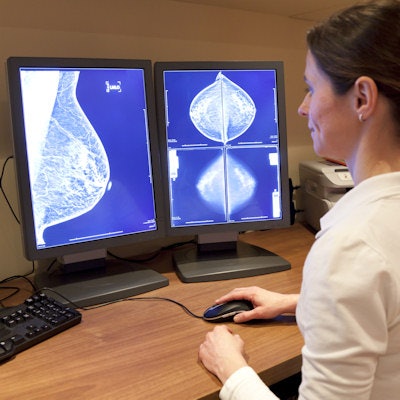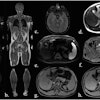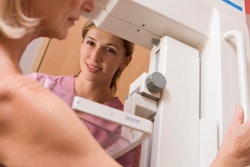
Using gridless mammography acquisition results in a lower radiation dose for the patient, according to new research from Denmark. The study involving more than 70,000 women demonstrated that gridless mammography acquisition with software scatter correction is an alternative to grid-based acquisition in mammography.
The study team compared breast screening performance metrics and radiation dose for the two image acquisition modes. Led by Ahmed Jibril Abdi, a medical physicist and doctoral candidate at Odense University Hospital, the group analyzed data from Southern Denmark, where the gridless mode was installed in November 2013. Patient dose saving of up to 36.4% was obtained with the gridless acquisition, they found.
"Overall, screening in gridless acquisition mode demonstrated equal sensitivity measured as the cancer detection rate difference and equal specificity compared with grid-based screening," they wrote (European Journal of Radiology, 18 June 2018).
To scatter or not to scatter
Clinicians constantly seek new ways to lower radiation dose to patients. In breast cancer screening, one such technique is the optimization of beam spectra for digital mammography. Another method is lowering patient dose and using noise reduction to mitigate effects of quantum noise in the image. Noise reduction helps distinguish between small malignant tumors and microcalcifications, according to Abdi and colleagues.
Also, another option for lowering radiation dose is acquiring digital mammography images without hardware antiscatter grid but using software to mitigate the scattered x-ray radiation.
"The antiscatter grid attenuates a certain amount of the primary (nonscattered) radiation," the study authors wrote. "When the antiscatter grid is removed, more primary radiation can reach the detector. It has been shown that patient dose can be reduced depending on the compressed breast thickness when the antiscatter grid is removed and a software scatter correction is employed."
Removing the grid lowers dose, but how well does it perform in a screening environment? That's what the researchers sought to find out by retrospectively analyzing data from the Danish National Breast Cancer Screening Program. With the program, women between the ages of 50 to 69 are offered a free screening mammogram every two years.
The research team included a total of 72,188 screening cases subdivided into two study populations: cases acquired before (50,071) and after installation of the gridless acquisition mode (22,117). They used Siemens Healthineers' Mammomat Inspiration mammography system.
To measure the entrance surface air exposure, the researchers carried out additional phantom tests. Polymethylmethacrylate (PMMA) attenuation plates with different thicknesses (20 mm to 70 mm in steps of 10 mm) simulated the compressed breast (21 mm to 90 mm) and a solid-state dosimeter was used.
Results are summarized in the table below:
| Comparison of grid vs. gridless mammography in Denmark | ||
| Grid mammography | Gridless mammography | |
| Cancer detection rate | 0.55% | 0.55% |
| Specificity | 97.96% | 98.11% |
| Recall rate | 2.59% | 2.44% |
Patient dose savings in gridless acquisition ranged between 13.5% and 36.4%, compared with grid-based acquisition, depending on breast thickness. The higher benefit of gridless acquisition can be found for thinner breasts for which the additional primary radiation allows lowering overall patient dose.
A potential study limitation is that the researchers used two different populations. Although the two populations were from the same geographical region and similar points in time, there could be a different distribution of cancer cases in the populations, the study authors noted.
"Additionally, the radiologists reading the images in both populations could be different," they wrote. "However, due to the large amount of screening cases in both populations, the impact of this kind of variability is expected to be low."



















